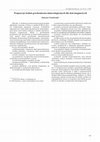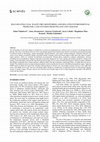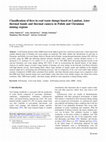Papers by Justyna Ciesielczuk
International Journal of Coal Geology

Mój g3os w dyskusji na temat przygotowania projektu g3êbokiego wiercenia w Polsce w ramach ICDP n... more Mój g3os w dyskusji na temat przygotowania projektu g3êbokiego wiercenia w Polsce w ramach ICDP nie dotyczy bezpoœrednio lokalizacji wiercenia. Chcia3abym zaproponowaæ rodzaj badañ geochemiczno-mineralogicznych, które warto by3oby wykonaæ w obrêbie ska3 krystalicznych, magmowych. Myœlê o przeœledzeniu przeobra¿eñ tych ska3 g3ównie na etapie hydrotermalnym, czyli innymi s3owy przeobra¿eñ spowodowanych dzia3aniem metamorfizmu hydrotermalnego. Najistotniejszym walorem tego typu badañ, wykonywanych na rdzeniu wiertniczym g3êbokiego otworu badawczego, by3oby przeœledzenie zmiennoœci geochemicznych oraz mineralogicznych wraz z g3êbokoœci1. W tym celu nale¿a3oby okreœliæ: sk3ad mineralny i chemiczny ska3y nieprzeobra¿onej sk3ad mineralny i chemiczny ska3y przeobra¿onej oraz wype3nieñ szczelin strefy, charakter oraz etapowoœæ przeobra¿eñ czêstotliwoœæ wystêpowania stref przeobra¿onych i ewentualna ich powtarzalnoœæ w pionie wiek bezwzglêdny wype3nieñ szczelin stopnie przeobra¿eñ...

Journal of Environmental Geography, 2021
The self-heating of coal waste dumps is considered as a serious environmental issue, wherever act... more The self-heating of coal waste dumps is considered as a serious environmental issue, wherever active or inactive coal mining has been present. This issue is introduced from two active coal mining regions from Poland (Upper Silesian Coal Basin) and Ukraine (Donetsk Coal Basin) based on mineralogy, organic petrography and geochemistry, and remote sensing techniques. Thermally affected coal wastes reveal changes recorded by organic and mineral matter. Irregular cracks and fissures appear within and at the edges of organic matter particles, which are oxidised, devolatilised and plasticised. Mineral phases underwent oxidation, dehydration, structure rebuilding and recrystallisation. Highest temperatures generated during the fire cause melting and paralava formation. During self-heating, some chalcophile elements like Hg (mostly present as HgS), Pb, Zn can be enriched and released, or different organic pollutants like phenols (originated from vitrinite particles), different PAHs with alky...

International Journal of Coal Science & Technology, 2020
A self-heating intensity index (SHII) based on the highest (pixel max.) and lowest (pixel min.) v... more A self-heating intensity index (SHII) based on the highest (pixel max.) and lowest (pixel min.) values taken from satellite thermal maps of burning coal waste dumps are proposed. The index enables the classification of such fires in Ukrainian- and Polish coal waste dumps. Both in Ukraine and in Poland, varying thermal intensities during 1985–2019 are revealed, using the SHII and following thermal intensity threshold values, namely, extreme thermal activity (> 7), advanced (3–7), moderate (3–1.5), initial (1.5–1), no activity (< 1). The SHII shows decreasing thermal activity in the selected Ukrainian coal waste dumps during 2017–2019. It aids in reconstructing the thermal history of the dumps. Analysis of satellite images revealed a large number of burning coal waste dumps in the Donetsk Coal Basin (Ukraine) with high thermal activity. Such burning likely reflects large amounts of organic matter and sulphides in the dumped material subjected to self-heating and self-burning pro...
International Journal of Coal Geology, 2017

European Journal of Mineralogy, 2016
A suite of 60 mineral samples with compositions intermediate between pseudomalachite, Cu 5 (PO 4 ... more A suite of 60 mineral samples with compositions intermediate between pseudomalachite, Cu 5 (PO 4 ) 2 (OH) 4 , and its arsenate analogue cornwallite, and between kipushite, (Cu,Zn) 6 (PO 4 ) 2 (OH) 6 ·H 2 O, and its arsenate analogue philipsburgite was investigated by electron-probe microanalysis, scanning electron microscopy, powder X-ray diffraction and micro-Raman spectroscopy. A wide range of compositions was found, covering 77.5 mol% and 75 mol% of the cornwallite–pseudomalachite and kipushite–philipsburgite solid solutions, respectively, demonstrating an extended P ↔ As substitution in these minerals. The analyses also reveal a Zn deficiency in the tetrahedral site of the kipushite–philipsburgite structure, leading to the crystal-chemical formula [4] (Zn,Cu) [6] Cu 5 (P 1−x As x O 4 ) 2 (OH) 6 ·H 2 O for this series. Raman spectra of the pseudomalachite–cornwallite solid solution are sensitive to the P/(As + P) ratio. The up-shift of a band assigned to the symmetric stretching vibrations of (AsO 4 ) group recorded in Raman spectra of the arsenate pseudomalachite is indicative of shortening As–O bonds and of bond-angle adjustment to accommodate the large As ions in the pseudomalachite structure. This feature is less evident in the arsenate kipushite, perhaps due its larger cell volume, where larger ions can be more easily accommodated in the anionic sublattice. Raman imaging and cluster analysis were applied to reveal chemical heterogeneity and structural disorder in the kipushite–philipsburgite solid solution.

Annales Societatis Geologorum Poloniae, Nov 21, 2012
The net work of faults and joints within the Me so zoic, Mio cene and Pleis to cene-Ho lo cene fo... more The net work of faults and joints within the Me so zoic, Mio cene and Pleis to cene-Ho lo cene for ma tions was stud ied in the Rio Colca val ley, in the Pinchollo-Lari-Maca area (Cen tral An des, south ern Peru). A com plex, multi-phase de vel op ment of these struc tures was re vealed. The re sults show that the struc tural frame work of the Rio Colca val ley con sists of WNW-ESE and NE-SW faults, and a few W-E faults. The strike of the most com mon fault sets is ap prox i mately par al lel (lon gi tu di nal) or per pen dic u lar (trans verse) to the W-E ori ented strike of strat i fi ca tion sur faces in the Me so zoic sed i men tary se ries and the W-E fold macro-struc tures, de vel oped in these strata. Di ag o nal faults and joints are less com mon, al though at some lo cal i ties they are nu mer ous. The re cur rence of ma jor fault sys tems through out the Me so zoic and Mio cene se ries and the Pleis to cene-Ho lo cene (mainly col lu vial) de pos its is proof of re cent, tec tonic ac tiv ity in the study area. The re cent fault ing has led to the de vel op ment of a sys tem of dis tinct, pri mary fault scarps, tec tonic grabens and horsts, as well as open fis sures, which are well marked in the sur face mor phol ogy, and in many cases have not yet been eroded.
Journal of South American Earth Sciences, 2013
ABSTRACT Sulphate mineralization precipitated around a geyser located above the village of Pincho... more ABSTRACT Sulphate mineralization precipitated around a geyser located above the village of Pinchollo, Chivay district and below Hualca Hualca volcano (6025 m a.s.l.) in the Western Cordillera of southern Peru is described. The geyser is one of many manifestations of thermal activity in the Arequipa department. Its age is estimated to be Upper Pleistocene-Holocene, as the discharge point lies at the intersection of a fault system with latitudinal dip-slip fault cutting a volcanic-debris avalanche of probably Pleistocene age. Thermal waters present in the Chivay district are mainly chloride-rich with a neutral pH. They are rich in Li, Sr, and B. The water erupting in the geyser boils at about 85 °C, as it lies at some 4353 m a.s.l.
Journal of Volcanology and Geothermal Research
The problem of ferruginous raw material provenance is complex and involves numerous methods and a... more The problem of ferruginous raw material provenance is complex and involves numerous methods and approaches [1,5,6]. Analysis of the chemical composition, with the usage of the statistical methods and geochemical interpretation has been widely used in the study of almost all provenance problems. We have decided to apply this mode of analysis to samples from the selected litostratigraphic levels with haematite bearing rocks. There has long been known, that haematite bearing rocks, though widespread in nature, are specifically bound to certain litostratigraphic levels. They appeared in the past geological periods due to favourable climatic conditions ruling in certain areas, i.e. arid and/or arid and hot regime. For the area of Central Europe some litostratigraphic levels are privileged and these are mainly: Lower Devonian (“Old Red”),
International Journal of Coal Geology
Coal and Peat Fires: A Global Perspective

Minerals
Coal seams in the Upper Silesian Coal Basin vanish within the Carboniferous Upper Silesian Sandst... more Coal seams in the Upper Silesian Coal Basin vanish within the Carboniferous Upper Silesian Sandstone Series and below an unconformity marking the Carboniferous top surface. Changes in the geochemical, mineralogical, petrological and palynological characteristics of gangue rocks associated with the vanished seams record what happened. The observed changes could have been caused by (1) coal-seam paleofire, (2) peat combustion, (3) igneous intrusion, (4) metasomatism and/or (5) weathering. Multifaceted research on samples collected at the Jas-Mos mining area, a part of the operating Jastrzębie-Bzie Coal Mine that are representative of different geological settings in the northern and southern parts of the mining area, point to intra-deposit paleofire as the most plausible reason for the disappearance. Biomarkers enabled recognition of differences in heating duration and oxygen access. Coal seams in the south burned quickly with abundant oxygen supply. Seams in the north pyrolyzed for a...











Uploads
Papers by Justyna Ciesielczuk